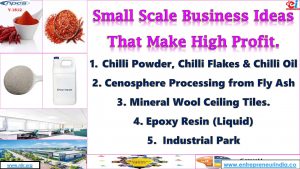
Small Scale Business Ideas That Make High Profit.
Starting your own company can be a daunting task. However, one of the finest emotions in the world is not having to follow the everyday and repetitive 9-5 office schedule any longer and being able to make all of your own decisions. However, due to a lack of cash, not everyone is able to realize their ambition of owning a business. But no longer! You can now start your own business and convert your passion into a vocation with various low-investment business ideas that also offer good earnings.
Start a Business in Africa, Click Here
Coming up with a business idea and starting a business can seem overwhelming and complicated. There are so many things you have to consider from coming up with an excellent idea to registering a company, all the way to business planning, fundraising and much more.
Start a Business in India, Click Here
Running a business can have a powerful impact on your life and the lives of those around you. But before you can run a business, you need to start a business. Deciding to start your own business can seem like a daunting prospect if you’ve never done it before. Luckily, plenty of other entrepreneurs have, and you can benefit from the wisdom they gleaned from their successes—and their mistakes.
Best Industry for Doing Business, Click Here
- Start Production Business of Chilli Powder, Chilli Flakes & Chilli Oil
Chili powder (also called as spelled chile, chilli, or powdered chilli) is the dried, pulverised fruit of one or more chilli pepper varietals, with or without other spices (where it is also sometimes known as chilli powder blend or chilli seasoning mix). It’s used as a spice (or spice combination) in cuisine to provide pungency (piquancy) and flavour. The sort of chilli pepper used to make chilli powder is occasionally used to identify it. The chilli peppers used to make chilli powder include Aleppo, ancho, cayenne, chipotle, chile de arbol, and jalapeo, New Mexico, pasilla, and piri piri.
Start a Business in Asia, Click Here
Crushed red pepper, often known as red pepper flakes, is a condiment or spice made from dried red chilli peppers that have been crushed rather than ground. The most common peppers used in this condiment are cayenne-type peppers, while commercial makers may utilise a variety of cultivars with Scoville units ranging from 30,000 to 50,000. Capsicum peppers are a variety of crushed red peppers with a fiery intensity. Red pepper chilies, which start off green before becoming orange-red to a deep dark red colour, are best cultivated in the summer months, when the temperature is between 70 and 84 degrees Fahrenheit and the weather is sunny.
Related Books: Spices And Condiments Cultivation
Related Videos: Processed Food Industry
Chili oil is a spicy condiment created from vegetable oil infused with chilli peppers. Different types of oil and hot peppers are used, as well as additional ingredients. It’s popular in Chinese cuisine, as well as East and Southeast Asian cuisines. It’s very popular in western Chinese cuisines like Sichuan, Hunan, Guizhou, and Shaanxi, where it’s used as a cooked ingredient as well as a condiment. It’s occasionally used as a meat and dim sum dip. It’s also used in jjamppong, a Korean Chinese noodle soup dish.
- Lucrative Business for New Startup Epoxy Resin (Liquid)
Epoxy resin is a reactive prepolymer and polymer that contains epoxide groups. These resins react either with themselves or with a variety of co-reactants such as amines, phenols, and thiols in the presence of catalysts. Epoxy resin is used in a wide range of industrial applications. It outperforms other types of resin in terms of mechanical qualities, as well as heat and chemical resistance. As a result, it is only used in the manufacture of aviation components.
Start a Business in Middle East, Click Here
Epoxy resin is a type of resin with robust mechanical qualities, excellent chemical resistance, and high adhesive strength, making it ideal for a wide range of applications. The following are some of the applications for epoxy resins:
- Metal coatings
- Use in electronic and electrical components
- Electrical insulators
- Fiber-reinforced plastic materials
- Structural adhesives
Related Books: Synthetic Resins, Oleoresins And Pine Chemicals Technology
Related Videos: Plastics Projects
From 2020 to 2027, the epoxy resin market is expected to grow at a CAGR of 7.0 percent, from $5.9 billion in 2019 to $10.3 billion in 2027. Epoxy resin is a thermosetting polymer that is made by copolymerizing an epoxide with a molecule that has two hydroxyl groups. Due to properties such as corrosion resistance, high thermal stability, superior mechanical strength, notable toughness, and prolonged durability, resistance to chemical and moisture, and superior adhesion, these resins are well-known for their improved performance in a variety of industrial applications. Epoxy resins are used in a variety of applications, including paints and varnishes, adhesives, composites, and electronic encapsulation.
A cenosphere is a light, inert hollow sphere consisting primarily of silica and alumina and filled with air or inert gas that is often created as a byproduct of coal combustion at thermal power plants. Cenospheres are grey to practically white in appearance and have a density of 0.4–0.8 g/cm3 (0.014–0.029 lb/cu in), giving them a lot of buoyancy. Cenospheres are a type of sphere that is hard and stiff, light, waterproof, poisonous, and insulative. As a result, they can be found in a wide range of items, including fillers. Cenospheres are increasingly commonly utilised as fillers in low-density concrete. Some producers have begun infusing metals and polymers with cenospheres to create lightweight composite materials with higher strength than other forms of foam materials, according to a 2016 article. Syntactic foam is the name given to such composite materials. Syntactic foams made of aluminium are finding use in the automotive industry.
Start a Business in Potential Countries for Doing Business, Click Here
Fly ash, also known as flue ash, coal ash, and pulverised fuel ash in the United Kingdom, or coal combustion residuals (CCRs), is a coal combustion product made up of particulates (fine particles of burned fuel) and flue gases that are expelled from coal-fired boilers. Bottom ash is ash that settles at the bottom of a boiler’s combustion chamber (also known as a firebox). Fly ash is often caught by electrostatic precipitators or other particle filtration equipment before the flue gases reach the chimneys in modern coal-fired power plants. It’s referred to as coal ash when it’s combined with bottom ash scraped from the boiler’s bottom.
Related Projects: – Fly ash based value added products, Coal Ash utilization, Fly Ash as Raw Material, Products from Waste Project Reports
Related Videos: – Fly ash based Value Added Products, Coal Ash utilization
The Cenospheres Market is expected to develop at a Compound Annual Growth Rate (CAGR) of 12.2 percent from USD 388.3 million in 2017 to USD 689.2 million by 2022. The market is likely to be driven in the future by rising demand from major end-use sectors such as paints and coatings, refractory, construction, and oil and gas. The market is hampered by a scarcity of raw materials and a lack of quality control in emerging countries.
- Emerging Opportunities in Setup an Industrial Park
An industrial park (also known as an industrial estate or a trading estate) is a designated area for the growth of industry. An industrial park is a more “heavyweight” variant of a business park or office park, with offices and light industry instead of heavy industry. Industrial parks are frequently found on the outskirts of, or outside, a city’s main residential area, and are usually well-served by public transportation, including road and rail.
Business Ideas with Low, Medium & High Investment, Click Here
A biotechnology industrial park is a type of industrial park that specialises in biotechnology. A bio-industrial park or an eco-industrial cluster are other names for the same thing. In cities like Singapore and Hong Kong, where land is scarce, flatted industries exist. Individual industries are housed in these buildings, which are similar to flats. Cargo elevators and roadways serve each level of the factory, enabling access to each production lot.
Books: BOOKS & DATABASES
A section of the city designated for industrial use is known as an industrial park. These areas are not intended for commercial or residential purposes. Ports, oil refineries, distribution centres, warehouses, and factories are all examples of industrial parks. The majority of industrial parks are located in places where the environment is favourable to industrial activity. In addition, industries are eligible for tax breaks if they locate their operations in a designated industrial park. Industrial parks are an important aspect of Texas’ economic infrastructure, serving as a significant magnet in the state’s economic development efforts to make it a location of opportunity and progress. A variety of things have an impact on the parks, and the parks have reciprocal effects on these factors.
- Manufacturing of Mineral Wool Ceiling Tiles
Ceiling tiles are a type of auxiliary ceiling that hangs below the main (structural) ceiling. Drop ceilings, also known as T-bar ceilings, false ceilings, suspended ceilings, grid ceilings, drop in ceilings, drop out ceilings, or ceiling tiles, are a common choice for both residential and commercial construction. Ceilings allow the installation of a dropped ceiling beneath existing fire sprinklers because the tiles, also known as melt-out ceiling tiles, are heat-sensitive and engineered to fall from the dropped ceiling suspension grid during a fire, allowing the sprinklers to shoot their water.
Looking for Most Demandable Business Ideas for Startups, Click Here
Drop down ceiling tiles can increase the aesthetic appeal of a ceiling because the fire sprinklers are hidden behind the tiles. Drop down ceiling tiles are generally made of vinyl or expanded polystyrene and are available from a range of manufacturers in a variety of sizes and finishes. Mineral Wool Ceiling Tiles Have a Wide Range of Applications:
- Concert halls
- Theaters
- Libraries
- Auditoriums
- Classrooms
- Meeting rooms
- Conference rooms
- Sport rooms
Related Books: Cement, Asbestos, Ceramics, Bricks, Limestone And Construction Materials Manufacturing Technology
Related Videos: Construction & Building Materials Projects
- Consulting rooms
- Concert halls
- Theaters
- Libraries
- Auditoriums
- Classrooms
Read our Book Here: The Complete Book on Cement & Concrete Products Manufacturing
Between 2020 and 2025, the Ceiling Tiles Market is estimated to reach $8.60 billion, with a CAGR of 9.1%. A spate of development projects are fueling the ceiling tile market. Another megatrend affecting the building and construction industry is the population boom in metropolitan areas, which necessitates low-cost housing.
For More Detail: Click Here
